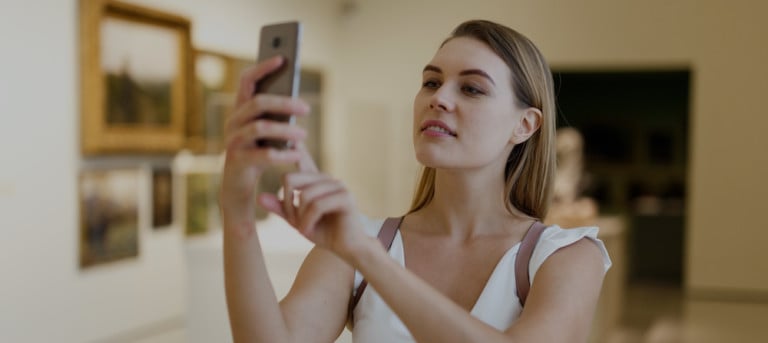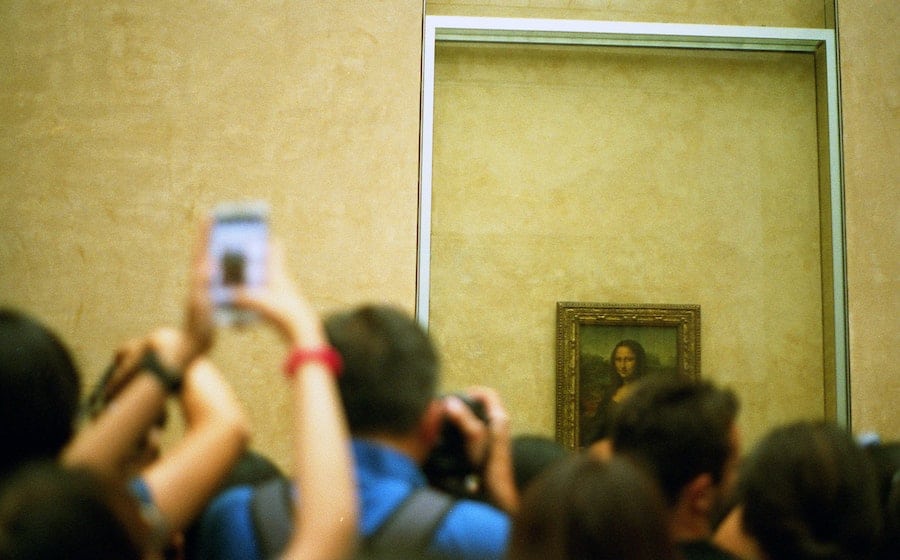Did you know that more people have a cell phone than own a toothbrush? Out of the 7.2 billion humans on the planet in 2016, 4.2 billion people had a mobile phone while only 3.2 billion owned a toothbrush.
by Barco
 It’s impossible to imagine a world without our mobile devices. We take them everywhere: to the supermarket, the office, the bar… But what about taking them into museums? Museums and mobile phones have a complicated relationship for multiple reasons.
It’s impossible to imagine a world without our mobile devices. We take them everywhere: to the supermarket, the office, the bar… But what about taking them into museums? Museums and mobile phones have a complicated relationship for multiple reasons.
Next to arguments about copyright issues and photo flashes potentially damaging the delicate artefacts, opponents have also claimed that using phones in museums would take away from the real-life experience. But is this really true?
In the fifth instalment of its blog series based on a discussion with museum panellists, Barco asked what these experts think about mobile phones in museums.
The museum leaders that contributed to this discussion are Arnold van de Water, partner at Factorr and general manager of the Meet Vincent van Gogh Experience for the Van Gogh Museum; Dave Patten, head of new media at The Science Museum, London; global thought leader, speaker, creative strategist, founder and director of Molten Immersive Art, Dorothy Di Stefano and Hilary McVicker, communicatrix at The Elumenati.
Museum etiquette
Let’s assume most people do take their phones with them during a museum visit. Do they also actually use them? At the Science Museum, Patten did some research in the past and it turns out that “the barriers are many and people are not that keen on using [their phones] in museums”.
One reason is that we’re too thoughtful and wary of what other people might think if we pull out our phones to take pictures of the collection pieces. It seems to be an unwritten rule in the established etiquette of museums.
Indeed, some museums still have a restriction policy in place when it comes to (flash) photography. And it might be for good reasons too, so guests should always respect that request. But more and more museums are welcoming mobile devices and are fully embracing photography by visitors with relaxed photo-taking rules.
Do it for the ‘gram
What’s more, the rise of the online social photo platform Instagram in particular and the explosive success of Insta-friendly pop-up installations have changed the way traditional museums organize their space with photographable elements.
It creates interactivity between visitors and the exhibition. The immersive digital art installations by ARTECHOUSE for example, just ask for selfies and pictures to be taken.

In addition, social media can also be an important promotion tool for museums. With people from all over the world active on Facebook and/or Twitter, giving their opinions on the products they buy, rating the books they read and movies they watch or writing about all kinds of experiences they want to share; social media is a way of reaching out to new audiences.
It’s like word-of-mouth advertising, but with one simple click, you can potentially reach more than hundreds of other social media users.
You can read more about the power of social media for museums in Barco’s ebook.
Extra experience

But there are many more ways museums can explore the use of mobile phones in their venues. Augmented reality, for instance. AR allows museums to add content about objects in the exhibition and humanize the stories of the collection. It shifts the way people look at objects, engaging them into the background story.
And iBeacon technology is another option. You can offer personalized information on a specific artefact based on the visitor’s location in the museum. Or, organize scavenger hunts similar to the extremely popular Pokémon Go. It’s the perfect mix of physical and digital using something people have ready in their pockets.
Looking at the future, mobile phones will become increasingly important in museums as interactivity tools. And especially important in the current situation: it’s COVID-proof.
See also: Please don’t touch: the rise of coronaproof museum technology
Diversified audience?
However, there’s one important side note to keep in mind. Although we started this post with the dazzling amount of people that do own a mobile device, there are still also visitors that don’t have access to a smartphone supporting apps and AR features. Make sure to provide alternatives that allow you to always include your entire audience of visitors in the interactivity of your experience.
Mobile phones and museums
The use of mobile phones has often been looked down upon by museum purists. However, over the last few years, this has started to change. When people look at their phones, it doesn’t necessarily mean they’re not interested in the collection. On the contrary, they might be looking up extra information on the work of art they just saw. Or sending a picture to their friends, telling what an amazing experience they’re having.
Museum curators and exhibition organizers are starting to recognize the advantages these mobile devices can bring to their venue in terms of promotion, communication and engaging experiences.
Read last week’s blog post on museums and edutainment here.










